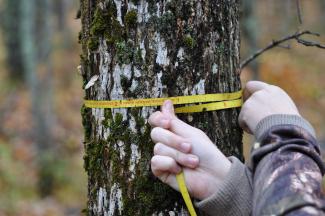Carbon & Greenhouse Gases

Carbon is one of the most important elements found on Earth. The carbon cycle supports all life by transferring carbon between living things and the environment. Plants take up carbon dioxide (CO2) and release oxygen (O2) during photosynthesis, which transfers carbon to their stems, roots, and leaves as they grow. When leaves fall and decompose or when plants die, the carbon that was stored in plants is released through respiration or combustion and transferred back to the atmosphere or to the soil.
Global concentrations of the most important long-lived greenhouse gases (GHG) in the atmosphere have increased measurably since the onset of the Industrial Revolution in 1750. Agriculture and forestry practices may either contribute to or remove GHGs from the atmosphere. Agriculture and forestry have contributed to GHGs in the atmosphere through cultivation and fertilization of soils, production of ruminant livestock, management of livestock manure, land use conversions, and fuel consumption.
Climate change is already having an impact on ecosystems across the world, and many of these changes are expected to continue or accelerate in the future. Opportunities to mitigate atmospheric greenhouse gas emissions is driving interest in managing carbon within ecosystems, highlighting the important role forests and grasslands play in sequestering CO2 and providing a source of renewable energy. At the same time, changes in the Earth’s climate system are altering forests in dramatic ways, which can also have consequences for the emission of carbon and other greenhouse gases.
-
Carbon Management in Northwest Agriculture
Farmers in the Northwest use a variety of management practices to increase carbon storage.
-
Understanding Northwest Forest Soil Carbon
The soil in Northwest forests can store carbon for centuries. However, climate change could affect the stability of…
-
Soil Carbon in the Northwest
Soil carbon is important for improving soil health and mitigating climate change in the Northwest.
-
Climate Change Considerations for Forest Operations in Northern Forests
Climate change is altering current weather patterns and may complicate forest operations. This guide presents climate…
-
Understanding Northwest Forest Carbon
Forests play a crucial role in mitigating climate change by storing carbon dioxide in their biomass and soil.
-
Climate and Management Effects on Soil Organic Carbon in Temperate Managed Ecosystems
Protecting soil carbon is crucial for effective carbon management, as reversing losses is slow and difficult. This…
-
Effects of Fire on Ecosystem Carbon in the Midwest and Eastern United States
Prior to European settlement, fire was a common disturbance across most of the Midwest and Eastern United States. Today…
-
Carbon in Non-Forested Wetlands of the Midwest and Eastern United States
Although wetlands make up a small percentage of total land area in the United States, they store a disproportionate…
-
Non-Native Invasive Earthworms in the Midwest and Eastern United States
Non-native invasive earthworms can significantly disrupt natural ecosystems. This resource explores the various effects…










